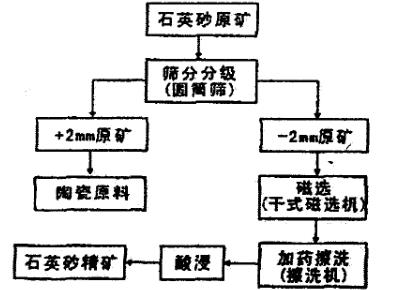
15311826613
Click to add WeChatQuartz is an important industrial principle and is used in glass, building materials, electronic materials, waterproof materials, anti-corrosion materials and other industries. In recent years, with the development of high-precision technology, the purification requirements for quartz sand have become higher and higher. Therefore, it is necessary to obtain high-purity quartz sand in the selection of mineral processing technology. The editor below introduces the high-purity quartz sand mineral processing and purification process in the form of a case.

The quartz sand is in the form of white dense blocks. Its main component is quartz, with a content of more than 96%. It also contains a small amount of hematite, limonite, ilmenite, garnet, and trace amounts of montmorillonite. Off stone, water biotite, etc. Through the analysis of mineral processing experiments, the quartz sand concentrator was finally designed: Raw ore-coarse crushing-hand selection-fine crushing-grading-magnetic separation-flotation-acid leaching-washing-dehydration-drying process process.

This stage mainly includes crushing-hand selection and fine crushing. The coarse crushing stage uses Jaw Crusher, the crushed products are sent to the next link by a belt conveyor, and manual selection is set up in the process During the operation, qualified quartz sand ore is selected in advance through mineral color. The minerals after hand selection will enter the roller crusher for fine crushing. After fine crushing, the qualified products enter the vibrating screen for screening, and the objects on the screen are returned to the roller crusher. The machine crushes it again, and the material under the screen enters the grinding and classification process.


The flotation process is mainly to remove mica and Fe2O3< in quartz /sub>, using XFb single-cell flotation machine, using H2SO4 as adjuster, pH=2.5~3, and sodium petroleum sulfonate as collector. Pine alcohol oil is used as a foaming agent, and quartz is obtained by flotation. After flotation, about 70% of the mica can be removed, and the Fe2O3 content can be reduced to less than 0.013%. .

The main purpose is to remove the harmful components present in the quartz particles after flotation (all in the form of spots or inclusions) On the surface), HCl, HNO3, H2SO4 and HF4 acids can be used, among which H2SO4, aqua regia, and HF have better Ti removal effects.
After the quartz sand is acid-leached, there are dissolved soluble impurity residues adhered to the surface, which need to be removed by washing. The washing process is a process that makes the quartz sand The process of diffusion of impurity compounds and residual liquid on the surface into the liquid phase. For washing after acid leaching I, use tap water (wash 3 times); for washing after acid leaching II, also wash with tap water first. When the washing liquid is close to neutral, wash with deionized water 3 times.

All washings use 20% solid concentration.
Dry at 120°C for 15-20 minutes to obtain the final high-purity quartz sand.
The above is the process flow plan for a certain quartz sand mineral processing and purification. In the actual mineral processing plant, different mineral processing methods need to be used for different types of quartz sand ores. Therefore, it is recommended to conduct mineral processing tests first and pass the experiments. Analyze, design a reasonable quartz sand purification process, and customize a suitable complete set of Quartz Sand Equipment to improve the overall Concentrator ROI.